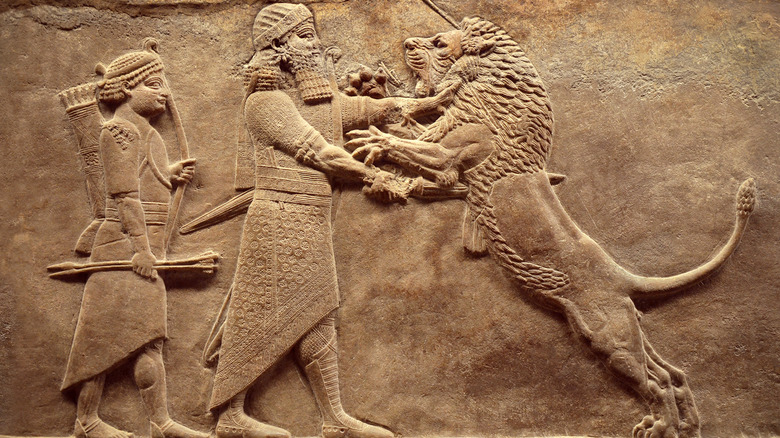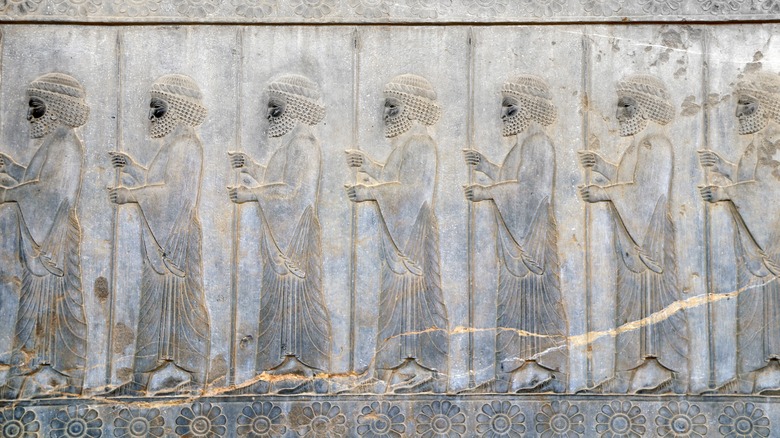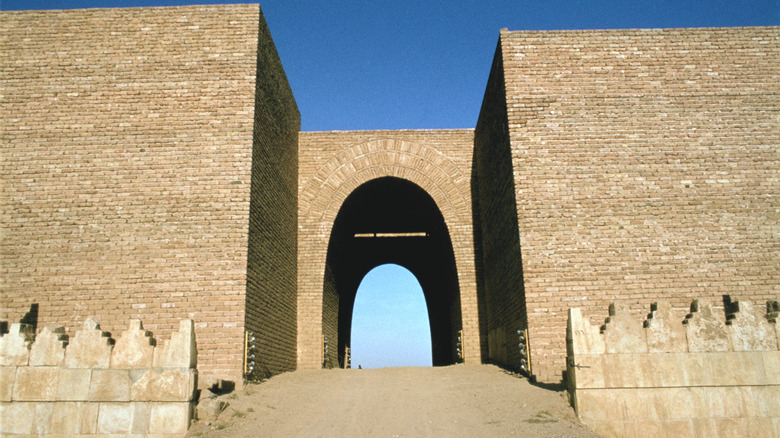The Ancient 2,700-Year-Old Carvings In Iraq That Have Survived ISIS Attacks
In Northern Iraq, archaeologists have discovered Assyrian artifacts dating to 2,700 years ago that miraculously survived the attacks launched by the Islamic State on the country's cultural heritage. The team, made up of both U.S. and Iraqi researchers, were located in the city of Mosul, or what was once the ancient city of Nineveh. The groups were in the area to work on the reconstruction of the Mashki Gate (meaning "Gate of God"), which was decimated by ISIS in 2016, per CNN.
Since 2014, ISIS has lain waste to precious antiquities housed at heritage sites and in libraries and museums across both Iraq and Syria. Assyrian artifacts perished under sledgehammers, drills, and explosives, with the Syrian ancient city of Palmyra notably plundered and destroyed in 2015 by the terrorist group (via Hyperallergic). Under the Mashki Gate, archaeologists found marble slabs that awed them with their ornate carvings depicting battles of ancient Assyria. In light of all the cultural vandalism the region has faced, this discovery stands as a ray of light to preservationists.
The Assyrian Empire
Assyria was located in Northern Mesopotamia, most of which was located in modern Iraq, as well as other parts of the Middle East like Turkey and Iran. In the second Millenium B.C., Assyria was a nation-state of relatively small stature. But they proved strong with their stable technological progress during times of war, so while other empires fell around them, Assyria's power in the region was able to grow steadily. By 900 B.C., a number of Assyrian kings expanded Assyria into a powerful empire, and it remained so until its collapse around 600 B.C. (via National Geographic).
In keeping with their military prowess, Assyrian art often depicted warfare and rituals. Kings wanted to see themselves lionized in grand reliefs carved in limestone and gypsum. Painted brightly at the time, the scenes showed victories in battle, mythical creatures, and hunts. Much of these carvings adorned their palatial temples, showing scenes of reception halls and thrones to magnify the king's image (via J. Paul Getty Museum). One of the empire's great kings was King Sennacherib, who moved the Assyrian capital to Nineveh and during whose reign (705 B.C. to 681 B.C.) the Mashki Gate was built (per Live Science).
History Whispers out of Ruin
The 2,700-year-old carvings are embedded in a newly discovered part of the Mashki Gate. The eight marble bas-reliefs show images of grapevines, palm trees, and display scenes of battle. Fadel Mohammed Khodr, leader of the archaeological team, said (via Aljazeera), "We believe that these carvings were moved from the palace of Sennacherib and reused by the grandson of the king to renovate the gate of Mashki and to enlarge the guard room." The carvings were safely under the soil of the gate even when ISIS bulldozed the site, and they are all archaeologists could salvage, per Live Science.
The find offers new research opportunities to pique the interest of archaeologists and art historians. According to CNN, discoveries of this sort used to be shipped to places like the British Museum and other Western cultural institutions, but Michael Danti — an archaeologist from the University of Pennsylvania — notes that the carvings are the property of Iraq. And as such, in the aftermath of the Islamic State's attack, researchers can now look forward to studying the Neo-Assyrian period of the marble slabs and further preserving Iraqi cultural history.


